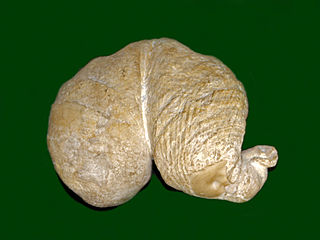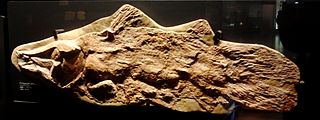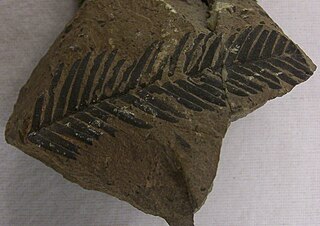 W
WThe Anacoracidae are an extinct shark family in the order Lamniformes. They lived throughout the prehistoric oceans during the Cretaceous period. The most numerous and well-known member of this family is Squalicorax, which was one of the most common marine predators during the period. Formerly, other shark genera such as Pseudocorax and Galeocorax were considered to belong to this family, on the basis of their similar teeth; however, a 2012 revision by Henri Cappetta moved these sharks into their own family, the Pseudocoracidae.
 W
WAsteracanthus is an extinct genus of Elasmobranchii.
 W
WBrachyopomorpha is a clade of stereospondyl temnospondyls within the infraorder Trematosauria. It was constructed in 2000 to include Bothriceps australis and the superfamily Brachyopoidea. It is phylogenetically defined as a stem-based taxon including Pelorocephalus and all taxa closer to it than to Rhytidosteus. In contrast, Brachyopoidea is defined as a node-based taxon including Brachyops and Pelorocephalus and all descendants of their most recent common ancestor. Because Bothriceps is not thought to be a descendant of that recent common ancestor and would be more basal than it, the genus is placed just outside Brachyopoidea and is considered to be a sister taxon to the clade.
 W
WCaprinidae is a family of rudists, a group of unusual extinct saltwater clams, marine heterodont bivalves in the order Hippuritida.
 W
WThe Caytoniales are an extinct order of seed plants known from fossils collected throughout the Mesozoic Era, specifically in the late Triassic to Maastrichtian period, around 250 to 70 million years ago. They are regarded as seed ferns because they are seed-bearing plants with fern-like leaves. Although at one time considered angiosperms because of their berry-like cupules, that hypothesis was later disproven. Nevertheless, some authorities consider them likely ancestors of angiosperms, whereas others consider angiosperms more likely derived from Glossopteridales. The origin of angiosperms remains an intriguing puzzle.
 W
WChresmodidae is an extinct family of insects within the superorder Polyneoptera.
 W
WCladophlebis is an extinct form genus of fern, used to refer to Paleozoic and Mesozoic fern leaves that have "fern fronds with pinnules that are attached to the rachis, and have a median vein that runs to the apex of the pinnule, and veins from that are curved and dichotomise". By convention this genus is not used to refer to fossil ferns from the Cenozoic. Ferns with this morphology belong to several families, including Osmundaceae, Dicksoniaceae and Schizaeaceae. Ferns with this morphology are common during the Paleozoic and Mesozoic in both the northern and southern hemispheres.
 W
WCycadeoidaceae is a family of bennettitalean plants which flourished in the Mesozoic era. Two genera, Cycadeoidea and Monanthesia, are currently recognised though most species are poorly known.
 W
WCycadeoidea is an extinct genus of bennettitalean plants known from fossil finds in North America and Europe. They lived during the Jurassic and Cretaceous periods.
 W
WDeinonychosauria is a clade of maniraptoran dinosaurs that lived from the Late Jurassic to the Late Cretaceous periods. Fossils have been found across the globe in North America, Europe, Africa, Japan, China, Mongolia, Manchuria, Madagascar, Argentina, and Antarctica, with fossilized teeth giving credence to the possibility that they inhabited Australia as well. This group of dinosaurs are known for their sickle-shaped toe claws and features in the shoulder bones.
 W
WDiceratidae is a family of rudists, a group of unusual extinct saltwater clams, marine heterodont bivalves in the order Hippuritida.
 W
WDicerocardiidae is an extinct family of fossil saltwater clams, marine heterodont bivalve molluscs, in the order Megalodontida.
 W
WDryosaurids were primitive iguanodonts. They are known from Middle Jurassic to Early Cretaceous rocks of Africa, Europe, and North America.
 W
WExogyra is an extinct genus of fossil marine oysters in the family Gryphaeidae, the foam oysters or honeycomb oysters. These bivalves grew cemented by the more cupped left valve. The right valve is flatter, and the beak is curved to one side. Exogyra lived on solid substrates in warm seas during the Jurassic and Cretaceous periods.
 W
WHarpagodes aranea is an extinct species of fossil sea snail, a marine gastropod mollusk in the family Harpagodidae. This species is found in deposits ranging from the Jurassic to the Cretaceous.
 W
WHemicidaridae is a family of extinct sea urchins characterized by large, massive, club-shaped spines.
 W
WLycopteridae is an extinct family of freshwater osteoglossomorph ray-finned fishes.
 W
WMawsoniidae is an extinct family of prehistoric coelacanth fishes which lived during the Triassic to Cretaceous period.
 W
WMegatrigoniidae is an extinct family of fossil saltwater clams, marine bivalve molluscs in the subclass Palaeoheterodonta. This family of bivalves is known in the fossil record from the Jurassic period, Tithonian age, to the Cretaceous period, Maastrichtian age. Species in this family were facultatively mobile infaunal suspension feeders.
 W
W†Nerinea is an extinct genus of fossil sea snails, marine gastropod molluscs in the clade Heterobranchia.
 W
WPalaeoniscidae is a family of fish who possessed a bony skeleton and operculum. This group of fish appeared in the Silurian, and died out in the Cretaceous.
 W
WPalaeontinoidea is an extinct superfamily of cicadomorph hemipteran insects. This superfamily contains three families.
 W
WPleurotomaria is an extinct genus of sea snails, marine gastropod molluscs in the family Pleurotomariidae.
 W
WSphenopteris is a genus of seed ferns containing the foliage of various extinct plants, ranging from the Devonian to Late Cretaceous.
 W
WToxasteridae is an extinct family of sea urchins.
 W
WTrematosauria is one of two major groups of temnospondyl amphibians that survived the Permian-Triassic extinction event, the other being the Capitosauria. The trematosaurs were a diverse and important group that included many medium-sized to large forms that were semi-aquatic to totally aquatic. The group included long-snouted forms such as the trematosauroids and short, broad-headed forms such as the metoposaurs. Although most groups did not survive beyond the Triassic, one lineage, the brachyopoids, continued until the Cretaceous period. Trematosauria is defined as all stereospondyls more closely related to Trematosaurus than to Parotosuchus, a capitosaurian.
 W
WWilliamsoniaceae is a family within the Bennettitales, an extinct group of seed plants within the Cycadophyta subdivision. Members of this family are believed to have been around two meters tall and with widely serrate leaves along a central stem. Reproductive organs of the Williamsoniaceae have varied widely in the fossil record but almost all have been found to be borne on stalks emerging from a ring of leaves.
 W
WThe Zygopteridales is an extinct order of ferns or fern-like plants which grew primarily during the Carboniferous. It comprises two families: Zygopteridaceae, which contains at least a dozen named genera, and Teledeaceae, which comprises two genera. A few other genera are of uncertain placement and are not assigned to any family yet.